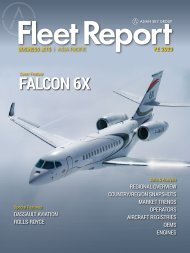You also want an ePaper? Increase the reach of your titles
YUMPU automatically turns print PDFs into web optimized ePapers that Google loves.
SPONSORED CONTENT<br />
According to Lau, that nagging doubt was unfounded, as not only<br />
have the steady stream of users that were first attracted to business<br />
aviation stuck around, but the numbers have swelled since China<br />
opened its borders again in early <strong>2023</strong>.<br />
But whilst Lau paints a rosy picture of the Chinese charter market,<br />
she also points out that the increase in charter users has brought<br />
with it an unforeseen problem, saying that there aren’t enough<br />
aircraft to satisfy the country’s demand for charter flights.<br />
“You’ve seen the travel patterns since January this year [when<br />
China opened its borders], it’s been crazy, people have been going<br />
everywhere,” says Lau. “But there aren’t enough aircraft.”<br />
Lau is partly referring to the number of aircraft that have left the<br />
Greater China business jet fleet over the past year, which, according<br />
to Asian Sky Group’s 2022 Business Jet Fleet <strong>Report</strong>, declined by as<br />
much as 15% in 2022.<br />
“Travel throughout Asia-Pacific has been strong, and travel to<br />
Europe and the US has been stronger than before. Japan is a very<br />
popular destination, and inside China. It’s just that we don’t have<br />
enough aircraft.”<br />
We have a self-owned Falcon 7X<br />
that we have leased to another<br />
company, and the operator just<br />
told me that last month the aircraft<br />
flew 100 hours. That’s how strong<br />
the demand is.”<br />
Lau also says that she’s noticed a shift towards charter from those<br />
owners that previously had their own aircraft but decided to dispose<br />
of them. These days she says that there is more of a trend towards<br />
charter, or even long-term leasing, but that there just aren’t enough<br />
aircraft available to satisfy the demand for charter.<br />
“You have to look at the overall economic cycle of Europe, the US and<br />
China. Because with interest rates rising for the past year or so in the<br />
US, everyone is waiting for the point where there is a sharp drop in<br />
the economic cycle,” says Lau. “Once that happens there will probably<br />
be more aircraft available on the market at a very discounted value. I<br />
think the more mature clients are waiting for that moment.”<br />
Another part of the reason that people are moving towards charter,<br />
especially in China, is the current long lead times that it takes<br />
between ordering a new aircraft and actually taking delivery of it,<br />
with Lau saying that for new aircraft types especially the lead times<br />
could be as long as two to three years.<br />
“People are kind of in a wait and see period at the moment. But<br />
some of them that are having very intensive travel demands will<br />
buy regardless.”<br />
With more people chartering, and Sino Jet possibly in the market<br />
for new aircraft, the company has begun to explore more ways of<br />
introducing what it likes to call ‘end -to-end’ travel. The company<br />
already owns a number of FBOs across China, with the most recent<br />
one opening up in Chengdu, but Sino Jet is already looking towards<br />
the future, and how it can integrate the next generation of eVTOL<br />
(Electric Takeoff and Landing) vehicles into its offerings.<br />
As such, the company has a set up a division that has acquired 100<br />
eVTOLs from Chinese manufacturer Aerofugia. The AE200 model<br />
that the company has acquired is planned to accommodate up to<br />
four passengers and can travel up to 300km.<br />
Although Sino Jet’s eVTOL division is still working out the finer<br />
details of what it plans to do with the eVTOLs once they arrive, it is<br />
likely that the company will base the aircraft at its FBO locations and<br />
fly them to and from the nearest locations that it can, to pick up and<br />
drop off its clients that have flown into, or will fly out of, its FBOs.<br />
This will help the company ingrain itself deeper into the travel plans<br />
of its clients, and, help it offer a more complete end-to-end travel<br />
solutions that its competitors can’t, initially at least, compete with.<br />
“That puts us in a situation where we might have to, perhaps, raise<br />
money to buy more aircraft to service our clients,” says Lau. “Or we<br />
could just bring in some outside resources and work with some industry<br />
peers to get the fleet adequately supplied for this part of the world.”<br />
Overall, Lau says that she can only see charter demand increasing in<br />
the region, whilst on the flip side she sees the number of new aircraft<br />
acquisitions falling, especially by those that previously brought<br />
aircraft for their own, or their own company’s usage.<br />
ASIA-PACIFIC CHARTER REPORT <strong>2023</strong> | 18
















